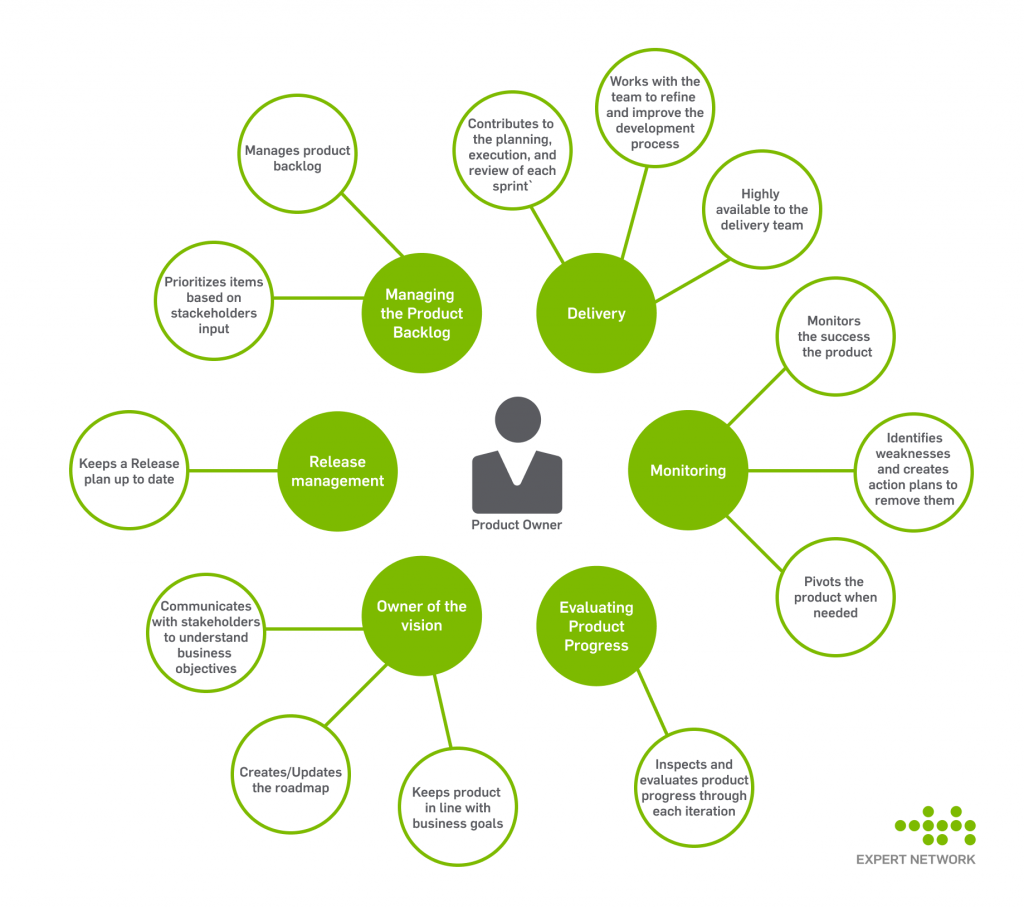How crucial is a Product Owner to an organization?
They can determine the success or failure of a business project. More precisely, they build the business case ensuring that the solution agreed upon with the customer stays aligned with the product roadmap and business goals. Yet, having a clear understanding of this position and its impact is riddled with misunderstandings. So let’s dig deeper to clarify these 3 points:
- the key duties of this role
- the importance of selecting the appropriate tools
- indicators for measuring a PO’s success
Key duties of this role
First, let’s define this position. A product owner is a leadership position within the product development, management, and marketing sphere. Simply put, he or she is in charge of a product. From concept to launch, this person works with the product development teams throughout the lifecycle of the product, even tracking its market performance.
POs assume a wide range of responsibilities, at-large representing the needs and desires of the customer and other internal organizational stakeholders or end-users to the rest of the Agile team.

Such a role requires experience and judgment to pull together all the stakeholders’ voices into a single, coherent message for the development team to follow.
Our PO, Vlad, provides valuable insight regarding the 8 main responsibilities of this position that narrows down to:
- identifying the customer’s pain points and needs which are defined as a story that is then translated to the team
- prioritizing the user stories from the backlog so that the team knows which stories to work on during the Scrum sprint
- managing product backlogs, sprints, and iterations
- ensuring quality control at each step of the delivery
- conveying and prioritizing the requirements or features of the product to the dev team
- mediating the technical part, the software, and development with the team and the stakeholders
- maintaining transparency and good communication with all the parties involved
- helping the product progress, maximizing the value for the users and the business
The importance of selecting the appropriate tools for the right outcomes
POs are responsible for a myriad of tasks, yet it is crucial that they select the right tools for the efficiency of the whole process. This way, they can determine how time, cost-efficient, and successful the work will be conducted. And at Expert Network, we constantly test and revise which tools can ease and improve our work. Depending on our needs, we will mention a couple of them, that we have grouped as follows:
1. For planning and creating the product’s roadmap
teamgantt.com is the perfect, simple solution for a product or release roadmap. It helps us stay organized with everything in one place and it’s easy to invite clients and teams to collaborate on our gantt chart or project plan.
We also use mainstream programs like Microsoft Excel and Google Sheets because they fulfill our requirements just as well and successfully.
2. For monitoring the project
hotjar.com assists us in analyzing traffic data (heat maps, recordings, polls, form analysis). It’s safe, intuitive and it’s a great way to keep in touch with different teams – marketing, delivery, UIUX support – to understand how the project can be improved.
optimezly.com is a very good, accessible tool for a/b testing. It is an online survey that allows us to discover trends or what to change to improve a product.
Google Analytics or Google Search Console allows us to check indexing status, monitor, maintain, and troubleshoot a product’s presence, to optimize visibility on its website.
For tracking and improving Code Quality and Security in our applications, we constantly use sonarqube.org.
3. For a visual representation of our delivery process
draw.io and lucidchart.com are excellent applications that help us better communicate with our stakeholders from the dev team to sales and support, keeping everyone informed and updated. They offer visual representation like diagrams, system overview, flows, etc.
But regardless of what anyone chooses, just as important is to keep all parties engaged and informed of them. By directing stakeholders to use these tools as well, we maximize the benefits and smoothly reach the desired goals.
Indicators for measuring a PO’s successful implementation
A good product owner has to demonstrate various qualities to be able to manage the diverse aspects of the job. And how he or she can measure the performance and success of the product will be decisive for their role.
But how can they measure performance?
It all narrows down to the business, the vision, the mission, the strategy, and their understanding of the product. And the first step is to clarify all of these directions, making sure they are quantifiable, easy to measure, and ultimately, actionable. At Expert Network, for instance, we’ve adopted a system for high-performance software delivery. In broad terms, we focus on:
- Deployment frequency
- Lead time for changes
- Time to restore service
- The change failure rate
By monitoring and measuring them, we obtain indicators that determine how well we are performing, to continuously learn and improve. Furthermore, our PO considers certain KPIs which are largely dependent on the type of product and the user we’re trying to reach. KPIs can be related to the product itself, the agile team, the delivery, end-users, etc. But to offer some clarity, we’ll list some examples that guide us:
- Is the backlog groomed enough to ensure sufficient stories for 2–3 sprints in the future?
- Are the stories specific and testable?
- Is the backlog a reflection of real business needs?
- Did we increase the value of the product?
- Did we improve ROI?
- Is the PO highly reachable for the team?
Vlad points out that with the right system in place, it is easier and more efficient to focus and measure the following:
The solution created. If it adds value to the customer, stays in line with the vision for the product, and the end-users are satisfied, the standard has been reached.
On-time delivery. When they correctly prioritize the customer’s requests, using the appropriate tools, it ensures they keep to their schedule.
Maintaining good customer relationships and communication. As PO, he is responsible for constantly being aligned with the customer’s needs and vision. He makes sure that the Product Backlog is visible, transparent, and clear to all, and shows what the Scrum Team will work on next.
Team commitment to delivering value.This is demonstrated when the team takes action and adjusts their behaviors based on feedback and new learnings. It is how, at Expert Network, we keep our standards and the agreed-upon level of delivery.
All things considered, POs have an important role because they manage the stakeholder’s needs and are the sole ambassadors of the agile team to the stakeholder. They can impact all aspects of a business, so they need to be visionary and focus on actions that matter. Without a proper product vision for a business, it becomes difficult to determine if they’ll be moving in the right direction with the project or start bleeding money.
Share this article on
Be part of our team
Reach your full potential and value. Visit our Careers page.
